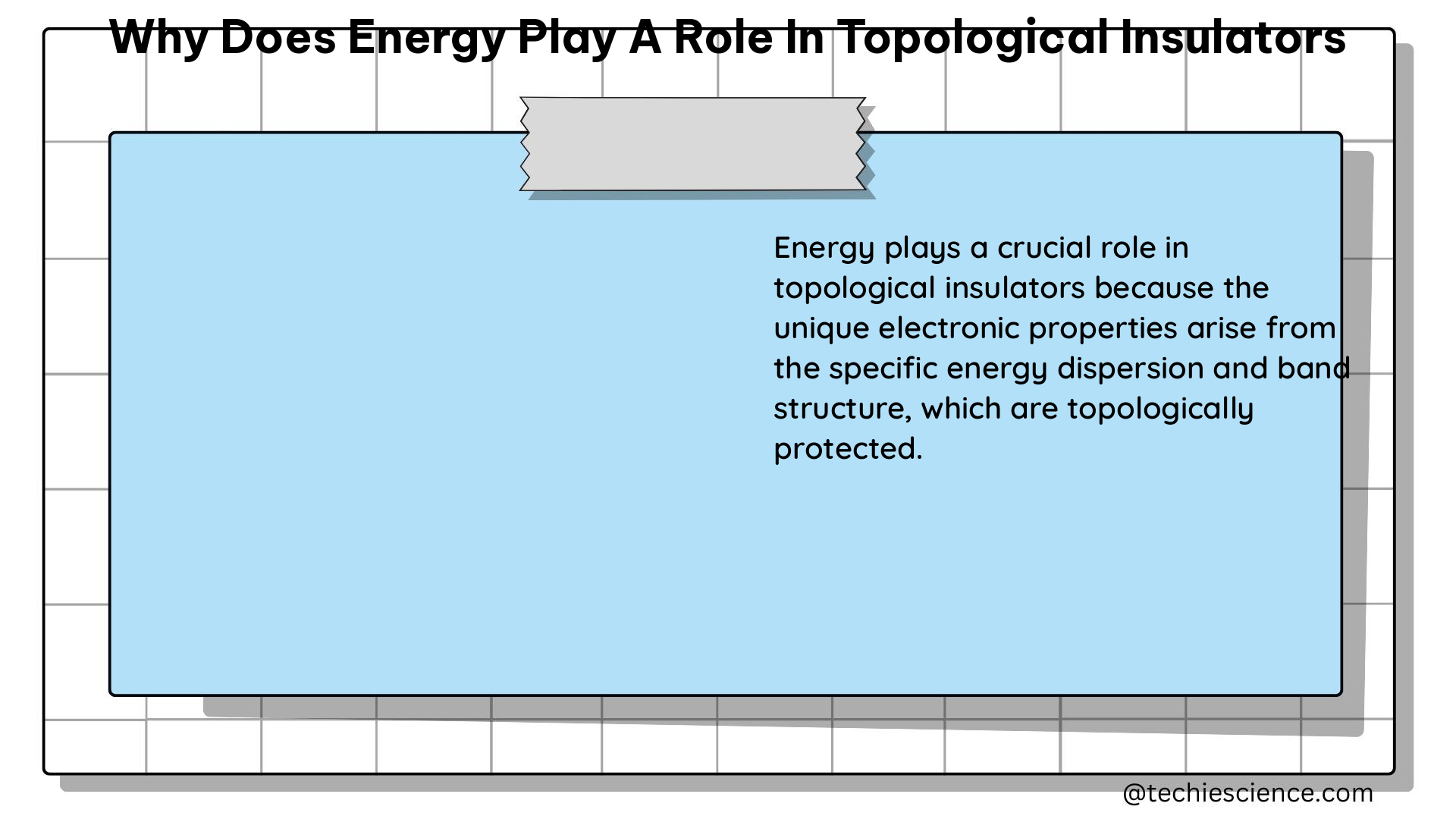Topological insulators (TIs) are a unique class of materials that exhibit insulating behavior in their bulk, while their surface or edge states are conducting. This unconventional property arises due to the topological protection of the surface or edge states, which ensures their robustness against impurities and defects. The conducting surface states are characterized by spin-momentum locking, a phenomenon where the momentum direction of electrons is directly related to their spin orientation, making them promising for spintronics applications.
Understanding the Band Structure and Energy Levels in Topological Insulators
The energy aspect of topological insulators is crucial for understanding their unique properties. The energy levels of electrons in a solid are described by its band structure, which determines the electrical properties of the material. In TIs, the band structure is such that the bulk is insulating, while the surface or edge states have a lower energy level, allowing for conduction.
The spin-orbit coupling, a quantum mechanical phenomenon linking an electron’s spin with its orbital motion, plays a pivotal role in the surface state conductivity and spintronics applications of TIs. The spin-orbit coupling splits the energy levels of the surface states, creating a spin-polarized Dirac cone-like dispersion, where the momentum direction of the electrons is directly related to their spin orientation.
The Role of the Quantum Hall Effect in Topological Insulators

The energy role in TIs is further highlighted by the quantum Hall effect, a phenomenon observed in two-dimensional electron systems under strong magnetic fields. The quantum Hall effect provides the conceptual basis for TIs, with quantized Hall conductance acting as a topological invariant linked to 2D materials under strong magnetic fields.
The quantum Hall effect was the first physical realization that topological states could exist, and it has evolved and found new realizations in TIs, expanding our understanding of quantum physics and materials science. The quantized Hall conductance in the quantum Hall effect is directly related to the energy levels of the electrons in the system, as it arises from the Landau levels formed by the strong magnetic field.
Technical Specifications and Theoretical Foundations
Topological Insulators: Materials with a bulk insulating property and topologically protected conducting surface or edge states.
Band Structure: The concept used to describe the energy levels that electrons can occupy in a solid, determining its electrical properties.
Spin-Orbit Coupling: A quantum mechanical phenomenon that links an electron’s spin with its orbital motion, influencing surface state conductivity and spintronics applications in TIs.
Quantum Hall Effect: A phenomenon observed in two-dimensional electron systems under strong magnetic fields, providing the conceptual basis for TIs and acting as a topological invariant.
Theorem: Bulk-boundary correspondence is a cornerstone in topological insulators, relating the topological properties of the bulk material to the presence of conducting states at the boundary.
Physics Formula: The energy levels in a solid are described by the band structure, which can be calculated using the Schrödinger equation.
Physics Example: Consider a TI with a band gap of 0.3 eV and surface state conductivity of 10^5 S/m. The energy difference between the bulk insulating states and the conducting surface states is 0.3 eV, and the surface state conductivity indicates a high concentration of mobile charge carriers.
Physics Numerical Problem: Calculate the Fermi level of a TI with a band gap of 0.5 eV and surface state conductivity of 5 x 10^4 S/m at room temperature (300 K). Assume that the density of states in the conduction band is constant and equal to 10^22 eV^-1 m^-3.
Figure: A band structure diagram illustrating the insulating bulk and conducting surface states in a TI.
Data Points:
- Band gap: 0.5 eV
- Surface state conductivity: 5 x 10^4 S/m
- Density of states in the conduction band: 10^22 eV^-1 m^-3
- Room temperature: 300 K
Value: The Fermi level can be calculated by equating the number of occupied states in the conduction band to the product of the density of states, temperature, and the energy-dependent density of states.
Measurements: The band gap and surface state conductivity can be measured using various experimental techniques, such as angle-resolved photoemission spectroscopy (ARPES) and scanning tunneling microscopy (STM).
Conclusion
In summary, energy plays a vital role in topological insulators, determining their unique insulating-conducting properties, influencing their surface state conductivity and spintronics applications, and providing the foundation for their conceptual understanding through the quantum Hall effect. The band structure, spin-orbit coupling, and quantum Hall effect are all crucial aspects that highlight the importance of energy in the understanding and applications of topological insulators.
References:
- Topological Insulators: Properties, Uses – StudySmarter
- Topological Insulators – an overview | ScienceDirect Topics
- Understanding Topological Insulators in Real Space – PMC – NCBI
- Phys. Rev. B 87, 195202 (2013) Parity–time-symmetric photonic topological insulator | Nature Materials

The lambdageeks.com Core SME Team is a group of experienced subject matter experts from diverse scientific and technical fields including Physics, Chemistry, Technology,Electronics & Electrical Engineering, Automotive, Mechanical Engineering. Our team collaborates to create high-quality, well-researched articles on a wide range of science and technology topics for the lambdageeks.com website.
All Our Senior SME are having more than 7 Years of experience in the respective fields . They are either Working Industry Professionals or assocaited With different Universities. Refer Our Authors Page to get to know About our Core SMEs.